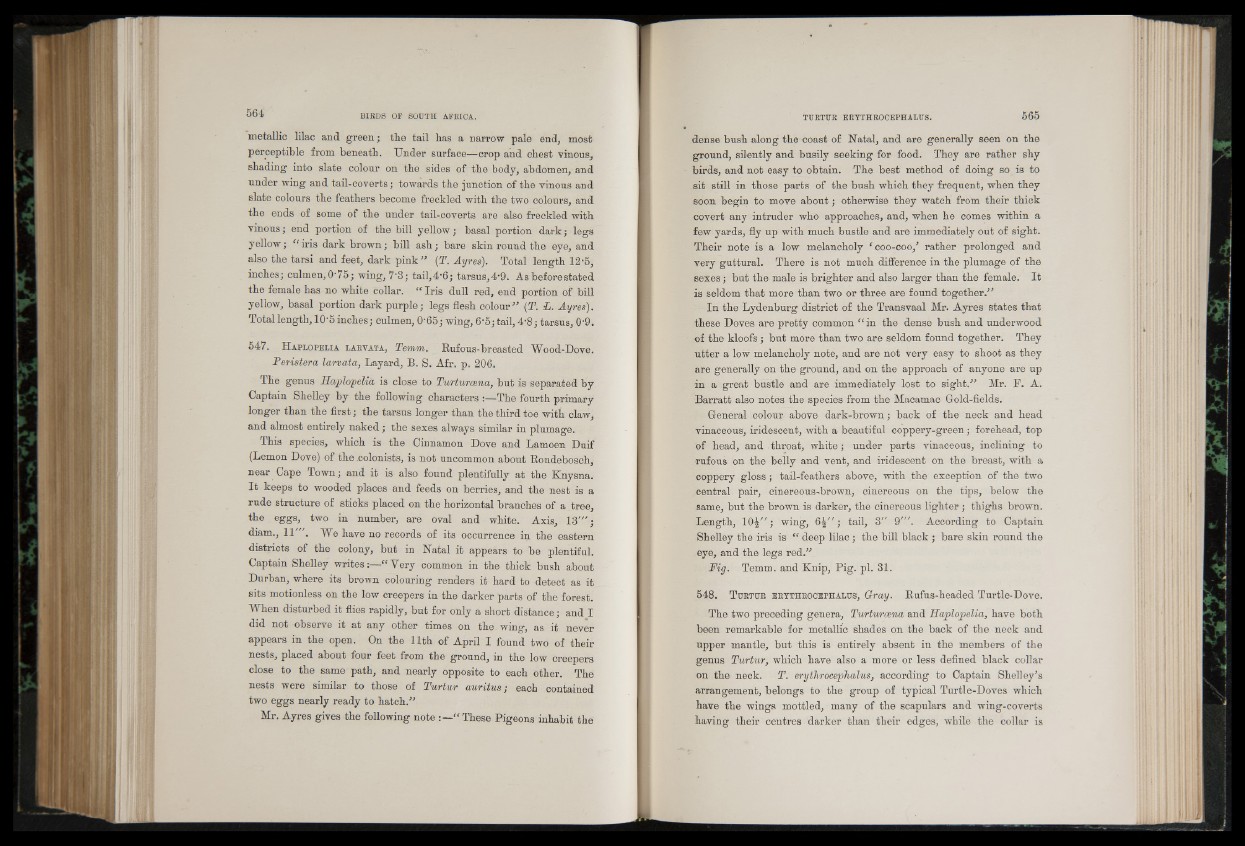
metallic lilac and green; the tail has a narrow pale end, most
perceptible from beneath. Under surface—crop and chest vinous,
shading into slate colour on the sides of the body, abdomen, and
under wing and tail-coverts; towards the junction of the vinous and
slate colours the feathers become freckled with the two colours, and
the ends of some of the under tail-coverts are also freckled with
vinous; end portion of the bill yellow; basal portion dark; legs
yellow; “ iris dark brown; bill ash; bare skin round the eye, and
also the tarsi and feet, dark pink” (T. Ayres). Total length 12'5,
inches; culmen,0'75; wing, 7‘3; tail,4-6; tarsus, 4'9. As before stated
the female has no white collar. ‘ Iris dull red, end portion of bill
yellow, basal portion dark purple; legs flesh colour” (T. L. Ayres).
Total length, 10'5 inches; culmen, 065; wing, 6'5; tail, 4'8; tarsus, 09.
547. H a p lo p e l ia larvata, Temm. Rufous-breasted Wood-Dove.
Peristera larvata, Layard, B. S. Afr. p. 206.
The genus Haplopelia is close to Turturcena, but is separated by
Captain Shelley by the following characters :—The fourth primary
longer than the first; the tarsus longer than the third toe with claw,
and almost entirely naked; the sexes always similar in plumage.
This species, which is the Cinnamon Dove and Lamoen Duif
(Lemon Dove) of the .colonists, is not uncommon about Rondebosch,
near Cape Town; and it is also found plentifully at the Knysna.
It keeps to wooded places and feeds on berries, and the nest is a
rude structure of sticks placed on the horizontal branches of a tree,
the eggs, two in number, are oval and white. Axis, 13"';
diam., 11” '. We have no records of its occurrence in the eastern
districts of the colony, but in Natal it appears to be plentiful.
Captain Shelley writes:—“ Very common in the thick bush about
Durban, where its brown colouring renders it hard to detect as it
sits motionless on the low creepers in the darker parts of the forest.
When disturbed it flies rapidly, but for only a short distance; and I
did not observe it at any other times on the. wing, as it never
appears in the open. On the 11th of April I found two of their
nests, placed about four feet from the ground, in the low creepers
close to the same path, and nearly opposite to each other. The
nests were similar to those of Turtur auritus; each contained
two eggs nearly ready to hatch/'’
Mr. Ayres gives the following note ¡—“ These Pigeons inhabit the
dense bush along the coast of Natal, and are generally seen on the
ground, silently and busily seeking for food. They are rather shy
birds, and not easy to obtain. The best method of doing so is to
sit still in those parts of the bush which they frequent, when they
soon begin to move about; otherwise they watch from their thick
covert any intruder who approaches, and, when he comes within a
few yards, fly up with much bustle and are immediately out of sight.
Their note is a low melancholy ‘ coo-coo/ rather prolonged and
very guttural. There is not much difference in the plumage of the
sexes; but the male is brighter and also larger than the female. It
is seldom that more than two or three are found together.”
In the Lydenburg district of the Transvaal Mr. Ayres states that
these Doves are pretty common “ in the dense bush and underwood
of the kloofs ; but more than two are seldom found together. They
utter a low melancholy note, and are not very easy to shoot as they
are generally on the ground, and on the approach of anyone are up
in a great bustle and are immediately lost to sight.” Mr. P. A.
Barratt also notes the species from the Macamac Gold-fields.
General colour above dark-brown; back of the neck and head
vinaceous, iridescent, with a beautiful coppery-green; forehead, top
of head, and throat, white; under parts vinaceous, inclining to
rufous on the belly and vent, and iridescent on the breast, with a
coppery gloss; tail-feathers above, with the exception of the two
central pair, cinereous-.brown, cinereous on the tips, below the
same, but the brown is darker, the cinereous lighter; thighs brown.
Length, UH” ; wing, 6^ " ; tail, 3“ 9"'. According to Captain
Shelley the iris is “ deep lilac; the bill black ; bare skin round the
eye, and the legs red.”
Fig. Temm. and Knip, Pig. pi. 31.
548. T u r t u r e r y t h r o c e p h a l u s , Gray. Rufus-headed Turtle-Dove.
The two preceding genera, Turturcena and Haplopelia, have both
been remarkable for metallic shades on the back of the neck and
upper mantle, but this is entirely absent in the members of the
genus Turtur, which have also a more or less defined black collar
on the neck. T. erythrocephalus, according to Captain Shelley’s
arrangement, belongs to the group of typical Turtle-Doves which
have the wings mottled, many of the scapulars and wing-coverts
having their centres darker than their edges, while the collar is